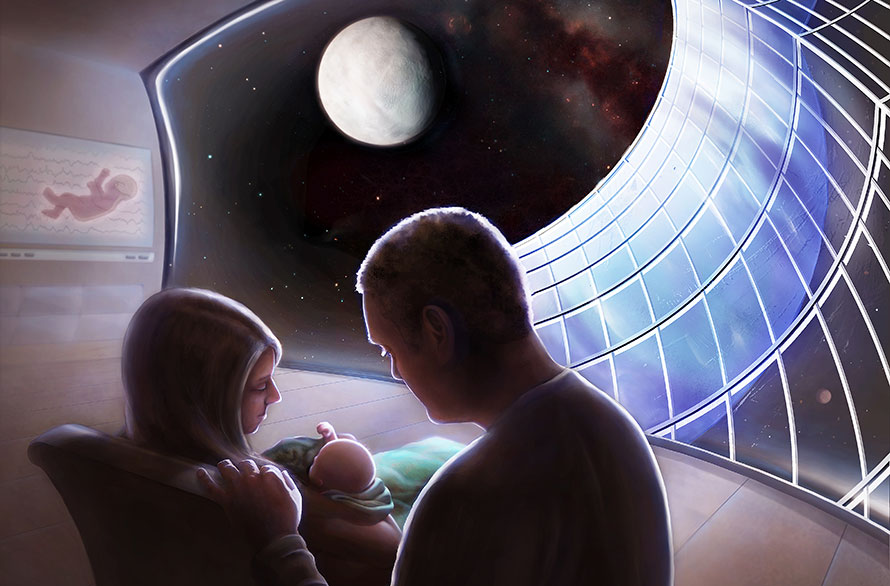Human reproduction and raising of children to adulthood over several generations in space.
 Image: Adrianna Allen, photonillustration.com
Image: Adrianna Allen, photonillustration.com
DESCRIPTION
Factors which could affect human reproduction may be different from those needed merely for survival. We know adult humans can survive periods of both lunar and micro gravity, reduced air pressure and oxygen levels, and some varying rotation rates (for artificial gravity generation in orbit), and background radiation rates. The limits for viable multi-generation human survival may differ, and should be investigated in other mammals and primates before committing to a major settlement in any proposed location. Other environmental factors may also need to be considered.
Demonstration of normal development of the mammalian life cycle is a high priority before humans attempt to raise children in large numbers in a given off-Earth location, to prove that there would be no significant or severe developmental abnormalities which could prevent normal operation and growth of a human settlement in that location. There are multiple conditions including gravity levels that could possibly cause developmental and health problems. Some of these conditions, such as gravity levels and radiation environments, are impossible or difficult to reproduce on Earth.
Even if a rotating space settlement has a 1 G artificial gravity field at the rim, there is still some possibility of developmental abnormalities (from the varying gravity levels toward the hub, the rotation itself, or the chemical and radiation environmental differences), that needs to be resolved to protect future children’s health and also the public relations aspects of space settlement itself. This means that the full range of conditions need to be tested when they vary from those on Earth. This applies to conditions on a terraformed planet as well as on a rotating space settlement.
The completion of the milestone for a single location does not necessarily remove a need for other locations which have different conditions to go through the same test sequence. Once normal development has been demonstrated at a given low gravity level and/or rotation rate, given the other assumptions of conditions as defined below, it can be assumed that development will also be normal at higher gravity levels up to 1 G and also with slower rotation rates at settlements with artificial gravity.
COMPONENTS
Verification of mammalian conception, gestation, live birth, and growth to adulthood for at least three generations at any proposed settlement site, first with rodents such as mice or rats, followed by small primates such as marmosets. The settlement site could be occupied by humans during the animal tests, but ideally no children would be conceived there until the animal tests are complete and successful. These tests would be followed by the conception, birth, and raising to adulthood of a limited number of children in the settlement environment.
Below is a list of conditions (and possible limits on them) that could possibly cause human developmental abnormalities or health problems and which need further investigation before humans settle in various locations.
- Gravity levels above or below Earth’s 1G could pose a developmental problem. Gravity levels on planets and moons cannot be controlled, but people can decide not to settle on objects where the gravity is below or above a level determined to be safe for human development. Given that the set of other conditions known to be safe on Earth is maintained, the gravity level issue itself is then primarily related (within our solar system) to settlements on worlds with low gravity levels, such as on the Moon or Mars.
- Artificial gravity on orbiting space settlements would be created by rotation. Past experiments with adult humans suggest that settlement rotation rates should be limited to no more than 2-4 rpm, although it has not been possible to test rates with a large rotational radius. Larger radii allow lower rotation rates at the same gravity level. Future tests in space will determine the appropriate rates and radii of rotation.
- Cosmic, solar and background radiation levels within a settlement habitat should be held to no more than those existing on Earth where somewhat higher than average natural levels are shown to cause little or no increase in developmental or health problems.
- Air pressure should be maintained by a majority component of nitrogen at a level sufficient to prevent an increased danger of flammability. As oxygen levels increase compared to nitrogen levels, the danger of flammability increases, except at air pressures too low to sustain life.
- Oxygen (partial pressure) levels might be somewhat less than those experienced by people living in the large high-altitude city of Quito, Ecuador. People give birth and grow to adulthood at even higher altitudes, but the small populations there could hide uncommon medical problems. Some human populations have adapted over thousands of years to living at extreme altitudes. However, many individuals have problems with altitude sickness at even lower elevations.
BARRIERS
- Lack of facilities to test plants and animals (especially mammals) in artificial gravity at different levels off Earth.
- Assumed difficulty of providing sufficient radiation shielding for rotating space settlements.
- Potential difficulty in testing the effects of the settlement location’s chemical environment (eg. outgassing, lunar dust, Mars perchlorates, etc.).
COMPLETION
This milestone can be considered achieved for a particular settlement site and design when the first third-generation human being there is conceived (of parents both conceived at the same settlement), and born and raised to biological maturity with normal health.
MORE OF THE NSS ROADMAP TO SPACE SETTLEMENT:






